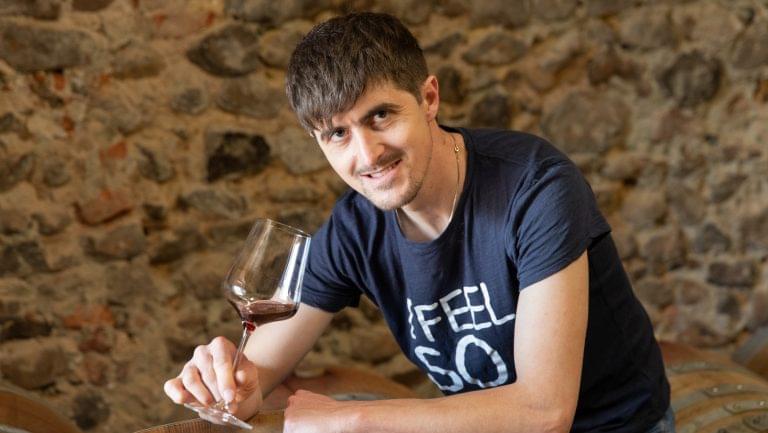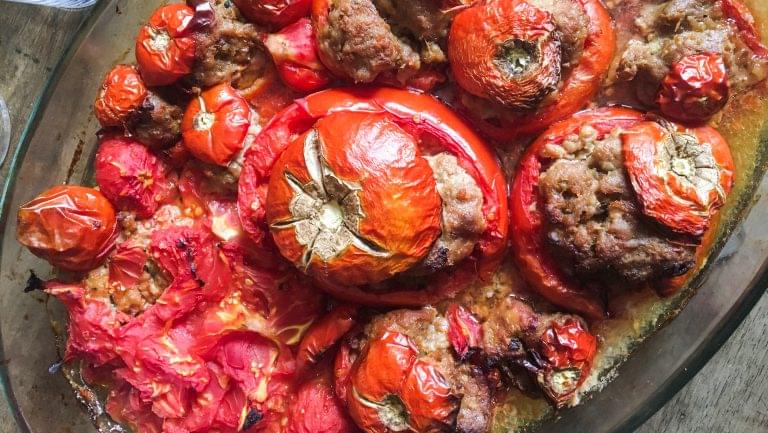Over the past decade, the region of Alto Piemonte in the northeastern corner of Piedmont, Italy, emerged from obscurity and started garnering international attention, and while no one can single-handedly resuscitate an entire winegrowing region, 34-year-old Cristiano Garella has played a significant role in this area’s reawakening.
“I want to realize the huge potential of the Alto Piemonte area by making wines that express its native grapes and complex mosaic of diverse terroirs,” says Garella, “and then bring them to the attention of as many people as possible—in Italy and around the world.” It’s an ambitious goal, but Garella has already made considerable headway and has had a tremendous impact on Alto Piemonte’s profile, galvanizing attention both at home and abroad. But, he says, “there is still so much to do.”
Garella was born in the tiny hamlet of Garella—a common local surname—in the small village of Castelletto Cervo near Biella. Though his family was not in the wine business (his mother was a secretary and his father a gymnastics teacher), Garella became intrigued by wine at an early age. He had his first sip at 6, and by the time he was 9, he already enjoyed scouring wine ads and articles in the newspaper. At 11, he bought a wine guide by Luigi Veronelli, and at 12, made his first pilgrimage to the Langhe with his older brother. “It was 1996,” he says, “and it was an exciting time. We visited all the greats—Angelo Gaja, Bartolo Mascarello, Giacomo Conterno—and they were all extraordinarily generous. I think they were amused to see two young kids who were really interested in what they were doing.”

Don’t miss the latest drinks industry news and insights. Sign up for our award-winning newsletters and get insider intel, resources, and trends delivered to your inbox every week.
Garella earned an AIS (Association of Italian Sommeliers) certificate in 2003. That same year, at 19, he enrolled in the Enology School of Alba, which he attended until 2006, when he received a remarkable offer from the Sella family to oversee the Tenute Sella winery in Lessona, after a member of the family read an article in a local newspaper about Garella’s passion for winemaking. “It was a great opportunity,” he says. “I learned a lot and I’m still friends with many of the people there. But it wasn’t enough. I realized I couldn’t work with just one winery—I needed to do more.” After five years, Garella began consulting; two years after that, he decided to go off on his own.
Today Garella is a partner in two wineries, Colombera & Garella in Masserano and Le Pianelle in Brusnengo, and an adviser to about 20 others. “It’s hard to keep count of them all,” he says, “because my role is always different and the relationships are very organic. Sometimes people just want me to come taste their wines and give my opinion. Sometimes this develops into a working relationship, sometimes not.” He typically drives 100,000 kilometers a year and gets more than 100 calls a day during harvest season.
Being involved with so many different wineries has led to him being a kind of spokesperson for the entire region. He frequently attends regional wine events as well as international ones. “I go to the U.S. and Canada five or six times a year to promote the wineries I work with,” he says, “with the help of longtime importer-friends like Oliver McCrum, Ernest Ifkovitz, Weston Hoard, Andy Pates, Max Stefanelli, and Cosimo Mammolitti.” He also typically attends the Vinitaly wine fair in Verona, the Slow Wine U.S. tour, and ProWein in Düsseldorf, Germany, where he looks forward to drinking “good Riesling and Gruner Veltliner.”
Besides his winery work, Garella started a wholesale wine distribution company, Ottobre Rosso (Red October), in 2012 with his longtime girlfriend, Giulia Schellino. Through Ottobre Rosso, the couple distribute wines from wineries Garella works with, as well as a small number of wines from other European producers, to restaurants and wine shops in the Alto Piemonte and Umbria regions and in Turin and Rome.
With all these different activities and a dynamic that changes with the season, Garella’s “typical” day is inevitably rather atypical. But here’s what an early spring day in the life of Cristiano Garella might look like:

8 am: Garella is usually up by 7:30. He lets his two dogs out, puts coffee on the stove, and meets with Andrea Zanetta, the managing partner of Le Pianelle, and Fabio Zambolin, who has a small, namesake winery near Lessona but helps out in the Pianelle vineyards, to discuss the day’s activities. After that, Zanetta and Zambolin get to work and Garella dives into tasting Le Pianelle’s new wines.
8:30–9:20 am: “Tasting is definitely the main activity in the spring,” Garella says, “and morning is the best time to do it. I prefer to taste at home whenever possible—it’s more convenient and there are no distractions.” After a cup of coffee he tastes the wines from the 2018 harvest. First up is a fresh Nebbiolo-based rosato called Al Posto dei Fiori that will soon be bottled and released, followed by various Nebbiolo, Vespolina, and Bonarda wines that are starting to mature in wood. He then samples all the 2017s from cask and barrel and finishes with the 2016 Bramaterra DOC that is resting in stainless steel. He’ll typically sample about 20 to 40 wines, but the tasting goes pretty quickly. “These are very young wines,” he says, “and I’m not deeply critiquing each one but mostly just checking in to see where they’re at.”
9:30–10:30 am: After 10 minutes and four phone calls, Garella arrives at Colombera & Garella to sample the new 2018 wines with his friends—and business partners—Giacomo Colombera and Giacomo’s father, Carlo. Though there are fewer wines to taste, it takes longer because the three inevitably discuss the wines and the harvest. Garella then heads across the river to Romagnano Sesia, near Ghemme, to visit one of the older wineries in the area, Ioppa, founded in 1852.
11 am: Garella has come to discuss the planting of a new vineyard with Giorgio Ioppa, who manages the estate with his sons, Andrea and Luca, and nephew, Marco. Wine from Ghemme, says Garella, as they walk the cleared parcel, “has plenty of roundness and concentration, but it often lacks finesse and elegance because of the thick layer of compact clay on top of the sand. It can take the vine 20 or 30 years to reach the sandy subsoil.” Garella advises Ioppa to remove the bulk of the clay before planting, an expensive operation that will be worthwhile, he says, “unless you want to wait 30 years to start making really great wine from this vineyard.”
12:30 pm: Having lingered at Ioppa a bit longer than anticipated, Garella heads for home when Schellino calls: One of Ottobre Rosso’s distribution clients needs an out-of-stock wine tonight, so he turns around, picks up the wine, and brings it to the restaurant. He also drops off samples at the Consorzio Tutela Nebbioli Alto Piemonte office in Ghemme before it closes at 1.
1:20 pm: By the time he gets to Ristorante alla Torre and delivers the wine, Garella realizes it’s too late to go home for lunch and calls Schellino to meet him, then orders a bowl of pasta, has a few glasses of wine, and chats with the owner. “I hate eating standing up or in the car,” he says, “and always sit down, even if it’s very quick.”
2 pm: When Schellino pulls up outside the restaurant, Garella has already had coffee and is waiting for her in his car. He heads north, with Schellino following in her car, and about 15 minutes later pulls off the road to the base of a forested hillside. When Schellino opens the car door, Garella’s dogs come bounding out to greet him. Then they all go for a walk, which is one of the constant fixtures in Garella’s mostly unpredictable schedule. He recalls that while on a walk last autumn, he came upon an abandoned farmhouse built in 1836, surrounded by what appeared to be former vineyards. After further investigation, the 5-hectare property was acquired by Le Pianelle and is now being restored.
4 pm: Schellino takes the dogs home while Garella heads to a meeting with a winegrower in Boca. His phone rings: A California importer wants to increase the quantity of an order that is about to be shipped and questions Garella about a producer from Sizzano he is considering taking on. Then another call comes in, from Frecciarossa in Oltrepò Pavese, the only winery Garella works with outside Alto Piemonte. Valeria Radici, the owner, is upset; she and her winemaker just tried their 2018 Sillery, a white Pinot Noir still wine, and think something might be amiss. Garella, who tasted it a few months ago, assures her that the wine is probably just going through a weird post-filtration phase but agrees to come check it out the next day, despite the 90-minute drive each way.
4:45 pm: Garella arrives late for his 4 pm appointment in Boca, though still well within the bounds of Italian propriety. The meeting with the prospective client goes well. The 2.5 hectares of Nebbiolo, Vespolina, and Erbaluce are well kept and the sites are looking good. The wines are good too, but Garella is already thinking of ways they could be even better.
6:30 pm: Garella rushes home, changes into athletic clothes, grabs his sports bag, and leaves.
7–9 pm: Tuesday night soccer with his regular squad is a weekly ritual Garella tries not to miss. Schellino shows up around 9, as the game is winding down.
9:30 pm: Garella and Schellino join a small group of players and their companions at Al Venti, a pizzeria in Biella with good food and a good wine selection (though Garella usually downs a beer first).
11:30 pm: Schellino stops at Garella’s place for a quick nightcap before returning home.

Dispatch
Sign up for our award-winning newsletter
Don’t miss the latest drinks industry news and insights—delivered to your inbox every week.
Alan Tardi has written about wine for many publications, including Wine & Spirits magazine, the New York Times, Food Arts, and Wine Spectator, and is the author of the James Beard Award–winning Romancing the Vine: Life, Love, and Transformation in the Vineyards of Barolo. His second book, Champagne, Uncorked: The House of Krug and the Timeless Allure of the World’s Most Celebrated Drink, received the Gourmand Best in the World Award (in the category of French Wine books). Tardi currently spends his time between Castiglione Falletto and New York City. Follow Tardi @terra.vite on Facebook and @alantardi on Twitter.






